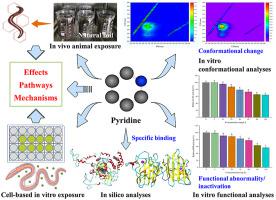Chemosphere ( IF 8.1 ) Pub Date : 2023-06-05 , DOI: 10.1016/j.chemosphere.2023.139139 Falin He 1 , Tianyu Qi 1 , Shuqi Guo 1 , Hao Wang 1 , Zhuo Zhang 1 , Rutao Liu 1 , Wansong Zong 2

|
Pyridine and its derivatives are widely used in many applications and inevitably cause extreme scenarios of serious soil contamination, which pose a threat to soil organisms. Still, the eco-toxicological effects and underlying mechanisms of pyridine-caused toxicity toward soil fauna have not been well established. Thus, earthworms (Eisenia fetida), coelomocytes, and oxidative stress-related proteins were selected as targeted receptors to probe the ecotoxicity mechanism of extreme pyridine soil exposure targeted to earthworms by using a combination of in vivo animal experiments, cell-based in vitro tests, in vitro functional and conformational analyses, and in silico analyses. The results showed that pyridine caused severe toxicity to E. fetida at extreme environmental concentrations. Exposure of pyridine induced excessive ROS formation in earthworms, causing oxidative stress and various deleterious effects, including lipid damage, DNA injury, histopathological change, and decreased defense capacity. Also, pyridine destroyed the cell membrane of earthworm coelomic cells and triggered a significant cytotoxicity. Importantly, the intracellular ROS (e.g., O2−, H2O2, and OH·–) was release-activated, which eventually inducing oxidative stress effects (lipid peroxidation, inhibited defense capacity, and genotoxicity) through the ROS-mediated mitochondrial pathway. Moreover, the antioxidant defence mechanisms in coelomocytes responded quickly to reduce ROS-mediated oxidative injury. It was conformed that the abnormal expression of targeted genes associated with oxidative stress in coelomic cells was activated after pyridine exposure. Particularly, we found that the normal conformation (particle sizes, intrinsic fluorescence, and polypeptide backbone structure) of CAT/SOD was destroyed by the direct binding of pyridine. Furthermore, pyridine bound easily to the active center of CAT, but preferentially to the junction cavity of two subunits of SOD, which is considered to be a reason for impaired protein function in cells and in vitro. Based on these evidences, the ecotoxicity mechanisms of pyridine toward soil fauna are elucidated based on multi-level evaluation.
中文翻译:

对吡啶暴露引起的赤子爱胜蚓模型毒性的机制见解:来自整体动物、细胞和分子视角的证据
吡啶及其衍生物的广泛应用不可避免地会造成土壤严重污染的极端情况,对土壤生物构成威胁。尽管如此,吡啶对土壤动物造成的毒性的生态毒理学效应和潜在机制尚未明确。因此,选择蚯蚓(Eisenia fetida)、体腔细胞和氧化应激相关蛋白作为靶受体,通过体内动物实验、细胞体外试验相结合,探讨吡啶土壤极端暴露对蚯蚓的生态毒性机制。 、体外功能和构象分析以及计算机分析。结果表明,吡啶对恶臭艾美拉产生了严重的毒性。在极端环境浓度下。暴露于吡啶会导致蚯蚓体内产生过多的ROS,引起氧化应激和各种有害影响,包括脂质损伤、DNA损伤、组织病理学变化和防御能力下降。此外,吡啶破坏了蚯蚓体腔细胞的细胞膜并引发了显着的细胞毒性。重要的是,细胞内ROS(例如O 2 −、H 2 O 2和OH· –)被释放激活,最终通过 ROS 介导的线粒体途径诱导氧化应激效应(脂质过氧化、防御能力抑制和遗传毒性)。此外,体腔细胞中的抗氧化防御机制迅速做出反应,减少ROS介导的氧化损伤。证实吡啶暴露后体腔细胞中与氧化应激相关的靶基因的异常表达被激活。特别是,我们发现正常构象(粒径、内在荧光和多肽)CAT/SOD 的主链结构因吡啶的直接结合而被破坏。此外,吡啶很容易与CAT的活性中心结合,但优先与SOD的两个亚基的连接腔结合,这被认为是细胞内和体外蛋白质功能受损的原因。基于这些证据,通过多层次评价阐明了吡啶对土壤动物的生态毒性机制。

































 京公网安备 11010802027423号
京公网安备 11010802027423号